#oga50 – There's a nasty old quip which defines mixed feelings as the emotions you experience while watching your mother-in-law drive your new Beemer over a cliff. Quite. But if you want to experience mixed feelings in a more socially acceptable way, try a visit to the Titanic Quarter in Belfast which, in its waterfront areas at least, manages to serve up high-speed mood swings whichever way you turn. Or so it seems to those of us who grew up in a sort of Titanic Disaster Denial environment.
There were many families in the greater Belfast area with an involvement at some level in the city's large and varied engineering industry. My mother's family was one of them. These clans took the loss of the Titanic to heart. It simply wasn't discussed in the family home. And if a stranger did happen to mention the T-word, the matter would be dismissed with a curt remark about there being seventeen other ships under construction in Belfast in 1912, and the loss of the Titanic was only a blip in the onward march of a great industrial port.
These days, things have lightened up a bit with the droll Belfast response that the ship was okay when she left Ulster. But then the pot is stirred again by the likes of Billy Connolly with his question as to what the Catholics of Belfast were doing when the Protestants were building the Titanic. The answer is they were building an iceberg.
For Belfast the feeling was that, as far as the fate of the Titanic was concerned, they wanted to move on. It was the rest of the world which was like an old dog with a bone, worrying away at a bit of receding history. But alas, the dog got younger, and the bone got juicier. And it was one of their own, Northern Ireland-born film producer William MacQuitty, who revived the story with an excellent movie which he called A Night to Remember, a double-edged title in light of Belfast's hidden wish to be allowed to forget.
After that, it was open season, culminating in James Cameron's special-effects-laden Hollywood blockbuster, made when blockbusters still made money. With the Centenary approaching in 2012, and Belfast needing investment in some visionary project to revive the moribund shipyard area where ship-building had ceased a decade earlier, there was nothing for it but to go with the flow, and go for it wholeheartedly. And now, with the extraordinary Titanic Belfast centre dominating the east bank of the River Lagan, they have a visitor attraction which, in terms of numbers crossing the threshold, is rivalled in the Irish context only by the Guinness Storehouse in Dublin.

The new Titanic Centre is at its most impressive at night Photo: W M Nixon
With the Titanic Belfast centre have come other consumer-friendly amenities, such as the new Belfast Harbour Marina. It's still in a fairly raw state, with Portaloos rather than a shower block, while finger pontoons have yet to be installed in the inner section. But that means there are many metres of clear walkway which provide easy berthing for slow-manoeuvring old gaffers of all sizes, so the OGA 50 Round Britain cruise-in-company descended on it last weekend big time.
Last week, we were discussing the reality that bowsprits are marina managers' nightmares, and were soon emailed the helpful info that in the trade, bowsprits are known as dock probes. Moreover, your dyed-in-the-wool old gaffer will think it an affront when marina staff try to charge him or her for berthing fees for the bowsprit. Indeed, a genuine old gaffer will think that, as the boat brings so much character and interest to an otherwise bland modern yacht harbour, not only should the management abandon any notion of being paid for the bowsprit, but as a gesture of goodwill and welcome, they should knock a metre or two off the length of the boat's hull for billing purposes.
Ideally, in fact, they should charge the Old Gaffers nothing at all. That's what Belfast was doing last weekend, so a very varied fleet was in the marina in the final burst of hyper-sunshine. And as the marina is in the Abercorn Basin, for those of us reared in the Belfast nautical tradition, it was just too good to resist, for the Abercorn Basin was the starting point for the epic cruise of the Calabar.
"The Cruise of the Calabar" is a cod-Irish ballad in that classic late Victorian style which is decidedly patronizing. But it's not the worst, so we'll tag it on at the end so that those of you who can't stand such things can make a timely exit. Meanwhile in Belfast we were fairly wallowing in nostalgia, with the OGA50 visit off the launching pad with a reception in the Harbour Commission Offices, which the blurb told us is an impressive 150-year-old ornate Italian-style palazzo.
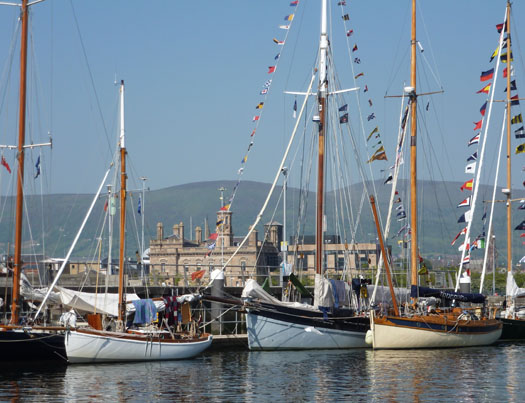
The Belfast Harbour office seen beyond Raven from the Netherlands, the pilot cutter Annabel-J, and the Heard 33 Toucando.
Photo: W M Nixon
Despite having spent some weeks in this palazzo during some work experience between school and college a very long time ago, I hadn't really registered its specially exuberant style, perhaps because Belfast – notwithstanding its being a very Presbyterian city – had acquired a remarkable number of Italianate buildings during its period of mega-growth in the latter half of the 19th Century. The place was up to its tonsils in Italianate buildings, and you could soon have enough of them. Then too, I was allocated to the engineers department, which was in a more workmanlike part of the building.
There, our day was punctuated each morning at precisely 10.30 by the determined squeak of the Harbour Engineer's shiny brown brogues as he strode purposefully down the corridor, resplendent in his immaculate tweed suit and with all the burly presence of a former rugby international, marching out the huge front door and straight across Corporation Square to the nearest bar, where he would down his first large whiskey of the day exactly a minute after opening time.
While the main parts of the Harbour Office may have been palatial, beneath it there was a warren of cellars where many of the rooms had been tastefully adjusted by the senior engineering staff for their own personal comfort. Long before the post-prandial power nap became recognized as an essential part of life for top executives, the senior engineers of Belfast harbour were practising it in their subterranean boudoirs, and it wasn't unknown for some of them to overnight for a few days when the nagging of their wives became intolerable.
As to being an intern in harbour engineering, all I can remember is that it was in the early days of echo sounders, and my work experience consisted in trundling off to some remote corner of the harbour in one of the well-appointed launches with a couple of dry-humoured engineers to spend some time discovering that the new echo sounder was on the blink yet again, and then heading back to base in order to be in the office for close of work.
These days, of course, the pace of work in Belfast Harbour engineers department is much more hectic, and only this week it was announced that they're about to build Ireland's first proper terminal to berth cruise liners. But it was a boat at the other end of the size scale which took pride of place among the Old Gaffers in the Abercorn Basin last Saturday, for there, sailing about as easy as you please, was Lilias, a restored Waverley class sloop.
The Waverleys are the quintessential Belfast Lough class. While the area's many upwardly mobile yachtsmen around 1900 were turning to the likes of Fife and Mylne and Linton Hope to design their burgeoning new One Design boats, down at Whitehead at the seaward end of the northern shore of the lough, the members of the very local if grandly named County Antrim Yacht Club were turning to one of their own, John Wylie, for the design of an 18ft keelboat which would be affordable, robust enough to cope with Whitehead's very exposed anchorage, and small enough to store in the boathouse.
Wylie was the technician in the laboratory of the Physics Department in Belfast's Queens University, and his work there was so highly regarded that, when he retired, they awarded him an honorary degree. As an amateur boat designer, his output was very small, but with the Waverley he hit the target spot on. At first glance, you'd think they're one of the Solent's famous X One Designs with the after end cut down from a sawn-off counter to a transom stern. But in fact the Waverley well pre-dated the X Boats of 1911, so these little Belfast Lough 18-foot keelboats are sui generis.
Little is the operative word – in size they're midway between a Mermaid and a Squib. Yet thanks to a full-bodied yet surprisingly fast hull, they can accommodate a reasonable cockpit with bench seats each side, making them much more comfortable to sail than, say, a Howth 17.
The first three boat were sailing off Whitehead by 1903. Initially the builder was the great Belfast backstreet boatbuilder Paddy McKeown, who couldn't read or write, but was a genius at interpreting boat plans. The class was soon popular, and they'd dozens of attractive boat names to draw on, as all were named after characters in Scott's Waverley novels. By 1906 Lilias was among those from McKeown joining the fleet. Once the boats went to Whitehead, they seldom if ever returned to the yard, so when Jeff and Janet Gouk brought their lovingly restored little boat into the Abercorn Basin from Bangor eight days ago, it was quite possibly the first time she'd been back in Belfast in 107 years.
The class is now only extant - and in a very limited way at that - in Bangor. Unfortunately, while the harbour there has a first class marina, there are no swinging moorings, which are important for supporting little old local one design classes. But despite the problems of getting in and out of their berth, people still love to sail Waverleys, and last year Lilias rounded out the season by being winner of the Lufra Cup, Ballyholme's time-honoured come-all-ye pursuit race.
In their heyday the class had strong fleets at both Whitehead, and Ballyholme across the lough, with very healthy inter-club rivalry. Inevitably the increasing popularity of bermudan rig brought friction. John Wylie would have nothing to do with it, so in 1935 some owners commissioned the designs for a Bermudan rig from Alfred Mylne in Glasgow. World War II interrupted the movement for a changeover, but when my uncle bought the Waverley Montrose (no 13) in 1945, he changed her to bermuda rig the following Spring.

The Waverley Class Montrose as she was in 1945 at Ballyholme, still carrying original gunter rig
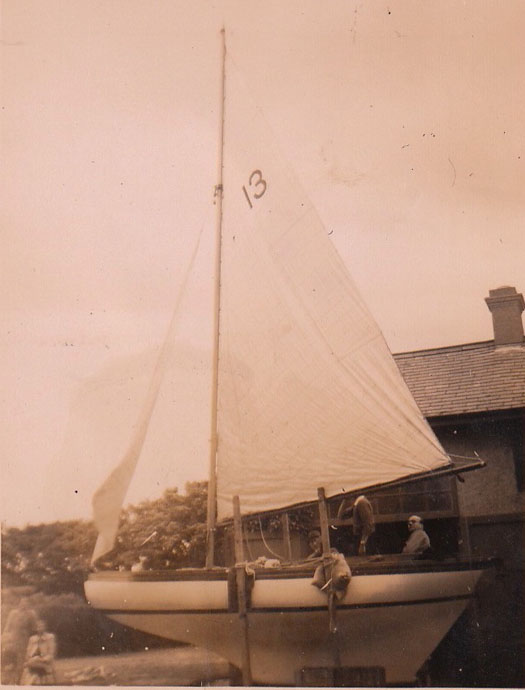
Montrose with a dry land trial for her controversial new Bermuda rig in the Spring of 1946.
My father sailed with him, and the two of them were like a pair of schoolboys, so impatient to see the new rig they put it up in the yard at home. Soon my father had his own Waverley, Rowena (no 1), and as she was already Bermuda rig, between the two boats there was quite a bit of success, especially in light breezes. Yet still other boats stuck with the original gunter rig, claiming that the only true Waverley was a gunter-rigged one, and disdaining the success of the Bermuda boats. So at the class AGM in April 1948, my uncle proposed and my father seconded a motion that all Bermuda boats revert to gunter rig. It sounds very sporting. But it was mischief-making typical of the two brothers-in-law - in a month's time, they were taking delivery of their new co-owned 25ft Glen One Design and exiting the Waverleys, leaving their former classmates with this contentious proposal simmering on the back burner for years.
It arose again in 1950 when the Bermuda-rigged Waverley Fair Maid foundered in a sudden gale while crossing Belfast Lough from Ballyholme back to Whitehead, with the loss of four lives. The class at Whitehead never really recovered from this tragic setback, and many lost faith in the gallant little boats. But then in 1961 brothers Kevin and Colm McLaverty, with Mick Clark as third hand, cruised round Ireland in handsome style from Carrickfergus with the Bermuda-rigged Waverley Durward, and the design resumed its rightful place of respect as a remarkably able little boat.
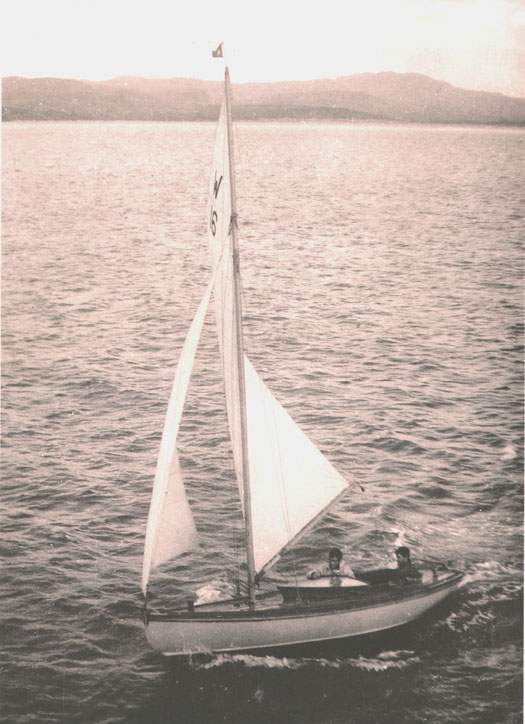
Durward at Sheephaven in Donegal during her round Ireland cruise in 1961. Photo: Kevin McLaverty
However, the class weren't finished with misfortune. By 1976, it was undergoing a new lease of life, with 13 boats all at Ballyholme, and all carrying gunter rig. But while Ballyholme Bay is a good passage anchorage in offshore winds, and a great place to sail, it's much too exposed for moorings. Yet in those days there was nowhere else in Bangor to keep a boat, and in September 1976 the Waverleys paid the price in a storm force northerly. The lucky boats were those that sank – they survived with only partial damage on the seabed. But those that were driven ashore became matchwood. And of the only two still floating, one sank the final inch while they were putting pumps aboard in the post-storm calm.
Yet the spirit of the Waverleys lived on, and by their Centenary in 2002-3, they were sailing as a class again. So the chance to sail aboard Lilias with Jeff Gouk – the first time for me in a Waverley since crossing the North Channel in Durward in 1961 - was top priority in Belfast, and every moment was pure joy. They're absolute honeys to sail, with good ergonomics, lovely handling, and everything as light as a feather.
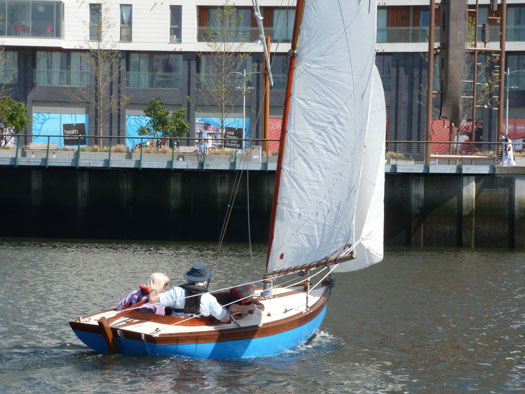
Lilias is all of a piece, a beautifully restored little sloop. Photo: W M Nixon
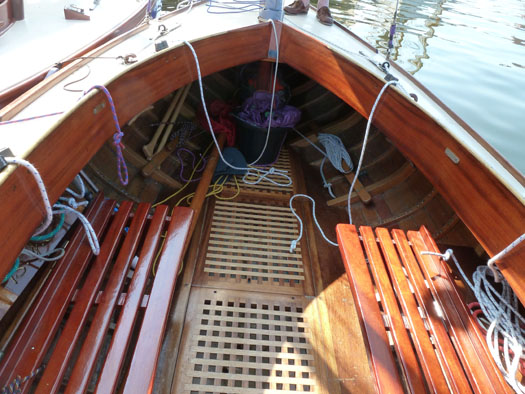
The cockpit on Lilias is much more comfortable than on many craft of similar size. Photo: W M Nixon
And there was new interest in the OGA 50 fleet, as Adrian "Stu" Spence's 1875-built Pilot Cutter Madcap had joined up, as had Isabel Hood's 1894-built Glance. There's one thing which all the old gaffer boats have in common. They're likable boats, every last one of them, and clearly their owners love them dearly. Thus with Madcap, the accommodation is so sensible and friendly, it could usefully be transposed to many modern boats. And as for Glance, that gallant old veteran which was already 61 years old when she won the Jolie Brise Cup for the Hopkirk brothers of Belfast in the 1953 Fastnet, she simply exudes good vibes on deck and below.
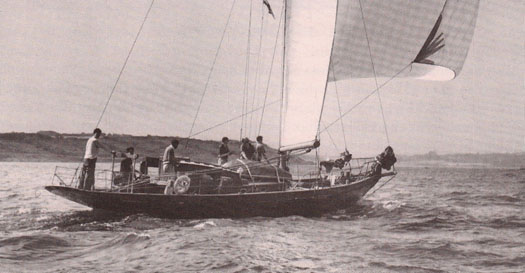
The 1894-built Glance on her way to winning the Jolie Brise Cup in the 1953 Fastnet.

Glance's attractive accommodation works well both at sea and in port. Photo: W M Nixon

The pilot cutter Annabel-J made for an ideal party boat Photo: W M Nixon
The Belfast visit was very much a voyage across the seaways of memory, and we made a point of heading for Tedford's seafood resturant on Donegal Quay for dinner after a fine old party aboard the big pilot cutter Annabel-J. In days of yore, Tedford's was the chandlers and sailmakers which were the first port of call in Belfast for any impecunious young skipper when fitting out. They carried an enormous stock, they would try to do things to old sails that no other sailmaker would contemplate, and they were very kind in extending credit until Christmas when there was a faint hope some kind aunt might see her way to a sensible cash gift.
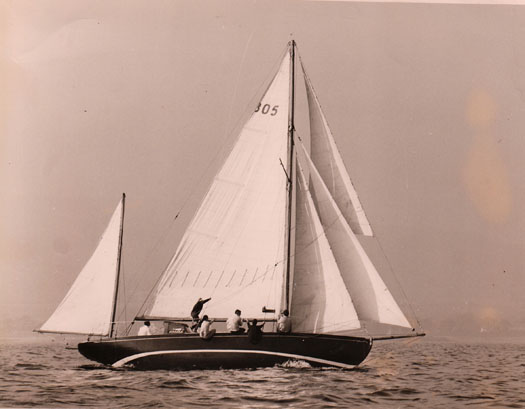
Ainmara with her "new" mainsail in 1967, re-cut from Griffin II's former sail with maximum economy by Billy the Twitch of Tedford's. Photo: Denis Pogson
It was a place of character and characters, whether it was Jimmy with his eternal duncher cap, I suppose you'd call him the sales executive, or Billy the Twitch, who was the sailmaker. Billy finally gave in to Dickie Gomes' persuasive powers and reduced the large second-hand mainsail somehow acquired from the RORC Club Yacht Griffin II into Ainmara's first terylene mainsail in 1967. It was such an economy job that he simply left half the sail number on the new leech. Though very heavy, it was an excellent sail, living testimony to Tedford's skill and tolerance

Tedford's classic and unchanged exterior today, with (left to right) Ed Wheeler, Dickie Gomes and Brian Law. But within, there isn't a trace of the old place as they knew it in the 1960s. Photo: W M Nixon
Anway, we dandered along to Tedford's in the velvet warmth of the summer evening, and it was reassuringly exactly the same outside. But inside, though the seafood is really good, there's not one single artefact or picture to remind you that this used to be a chandlery and sailmaker so perfect it was like a stage set. Instead, you've just another 21st Century restaurant.
So the meal was fine, but we felt a little cheated. But the next item on the agenda was the real McCoy, the first function to be held aboard the newly-restored Nomadic, which was the tender ship which took the passengers from Cherbourg out to the Titanic in April 1912. Superbly organized by Alan and Irene Aston of the Belfast OGA, this party was mixed feelings with turbo-power. You don't need much imagination to visualise the passengers of 1912 crowding the little ferry ship. You don't need any imagination – the Nomadic is crammed with ghosts.

The haunted ship. The Nomadic is crammed with ghosts. Photo: W M Nixon
And outside, glowing in the night, was the astonishing Titanic building. We'd a special link to this, as its remarkable exterior surface was designed was created by Alan Grimason. Back in the day, "Grim" (he's anything but) was an early crewman on Ainmara, and he was the man to call on for name-painting on boats at the right price. We still have the boats being run if at all possible at the right price, but with his Titanic building Alan has moved on – it's remarkable in daylight, at night it's astonishing.
On Sunday morning, boats were already moving on towards Scotland. But for the many who stayed, there was a river-cruise up the Lagan for a very good barbecue at the new pub at Cutter's Wharf. They were to have yet another party on a barge in the city that night, but several of us took our farewell from the OGA50 rolling circumnavigation at Cutter's Wharf. And where better? For we had just re-lived the Cruise of the Calabar:
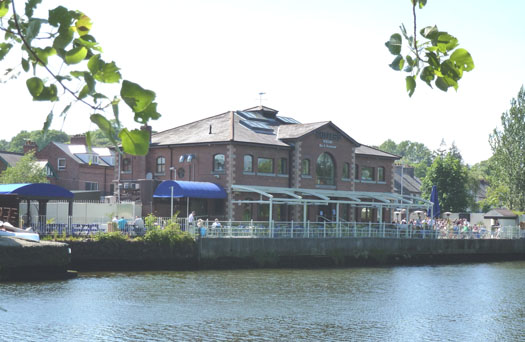
Destination for a 21st Century Cruise of the Calabar – Cutter's Wharf on the River Lagan at Stranmillis in south Belfast.
Photo: W M Nixon
The Cruise of the Calabar
Come all ye dry-land sail-y-ors and listen to my song,
"Tis only forty verses, so I won't detain yous long,
It's all about the voyagings of this old Lisburn tar
Who sailed as man afore the mast aboard the Calabar.
Now the Calabar was a spanking craft, copper-fastened fore and aft,
Her helm it stuck out far behind, and her wheel a great big shaft,
With half a gale to swell each sail, she'd make one lock per hour,
She's the fastest craft on the Lagan canal, and only one horse-power.
The Captain was a strappin' lad, he stood full four foot two,
His eyes was black, his nose was red, his cheeks a Prussian blue,
He wore a leather med-i-al that he won at the Crimea war,
And his wife was steward and passengers' cook aboard the Calabar.
"Come here me lad" the captain says, "come here" says he to me,
"Would you like to be a sail-y-or and roam the raging sea?
Would you like to be a sail-y-or the foreign seas to roll
For we're under orders for Portadown, with half a ton of coal."
We left the Abercorn Bas-i-on, the weather it being sublime,
And passing through the old Queen's bridge we heard the "Albert" chime.
'Tis then we came to the Gasworks Straight, a very dangerous part,
And ran head on to a lump of coal that wasn't marked on the chart.
Then all became confus-i-on, the stormy winds did blow,
The mate slipped up on an orange peel and fell into the hold below,
The captain called for much more steam, for we were sorely pressed,
But the engineer from the shore replied, "The oul horse is doing his best."
Next morning when we wak-i-oned, we was in a terrible funk,
The mate he had been drownded dead while sleeping in his bunk,
To save the ship from sink-i-ing, and to save each precious life,
We threw the cargo overboard, along with the captain's wife.
A farmer going to his work did hear our piteous roar,
He threw us the end of his galluses, and pulled us to the shore.
I'm done with ocean rambl-y-in', and roamin' the ragin' main,
And the next time I go to Portadown, I'll go there by the train.































































